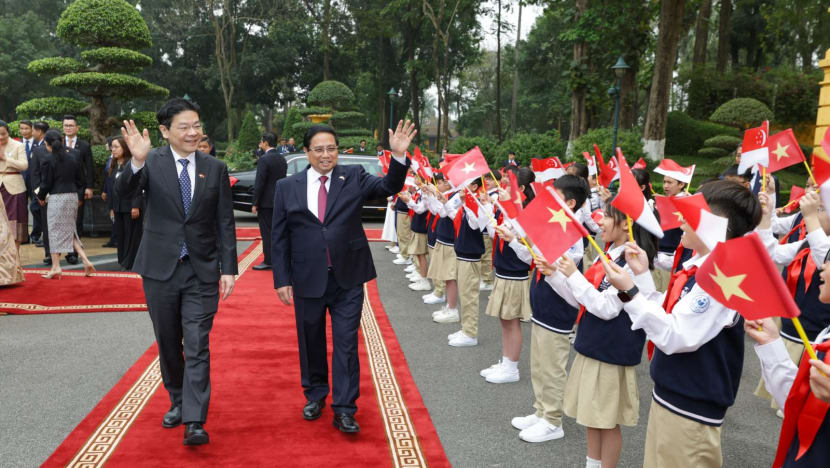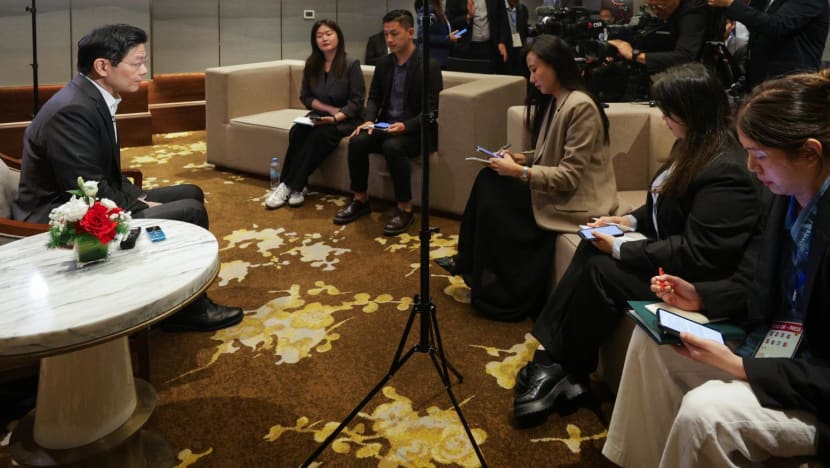Singapore, Vietnam sign five agreements across digital development, people ties, electricity trade
Bilaterals ties within ASEAN can strengthen the bloc's wider integration and unity, though "each relationship will evolve at its own pace", said Prime Minister Lawrence Wong at the end of his two-day Hanoi visit.

Prime Minister and Minister for Finance Lawrence Wong at the welcome ceremony in Hanoi with Vietnamese Prime Minister Pham Minh Chinh at the Presidential Palace on Mar 26, 2025. (Photo: Ministry of Digital Development and Information)

This audio is generated by an AI tool.
HANOI: Singapore and Vietnam signed five agreements across sectors such as energy and financial services on Wednesday (Mar 26), as Prime Minister Lawrence Wong and his counterpart Pham Minh Chinh reaffirmed the strong ties between both countries.
Mr Wong and Mr Chinh also broke ground for the new Vietnam-Singapore Industrial Park (VSIP) in Thai Binh province, the latest in a line of projects which Mr Wong called "the cornerstone of our bilateral cooperation for almost three decades".
There is significant scope for both countries to pursue sustainable and resilient growth together, said Mr Wong, on the second day of his visit to Hanoi.
Earlier in the day, he visited the Ho Chi Minh Mausoleum, where he laid a wreath.
AGREEMENTS ACROSS SECTORS
Both prime ministers observed the five exchanges of letters between officials on both sides, at the Office of Government in the Vietnamese capital.
They included letters of intent to implement the recently announced Comprehensive Strategic Partnership (CSP) and to facilitate cross-border electricity trade as part of the wider ASEAN power grid.
There were also three memoranda of understanding (MOUs) on digital development and innovation, people-to-people exchange, as well as cross-border QR code payment between both sides.
Mr Wong noted the close economic cooperation between Singapore and Vietnam.
“Last year, we were the largest foreign investor in Vietnam, with over US$10 billion in foreign direct investment,” he said.
“So before too long, we may become number one cumulatively too.”
Mr Wong highlighted key initiatives between both sides, such as the import of low-carbon energy into Singapore through renewable energy projects and the laying of subsea cables, as well as discussions on carbon credits collaboration.
“We hope that these mutually beneficial collaborations will be able to advance in good time and have the support of Vietnam’s central and local authorities,” said Mr Wong.
CORNERSTONE OF COOPERATION
Separately, Mr Wong and Mr Chinh witnessed the conclusion of four MOUs for the VSIP project.
“From the beginning, they have set the benchmark for industrial park development in Vietnam, providing international-standard infrastructure to investors, enabling them to operate seamlessly," said Mr Wong.
He added that both sides can develop the project so that they go beyond just industrial parks into other areas like science and technology and urbanisation.
There are currently 20 such parks located across 14 provinces in Vietnam. These have brought in over US$23 billion in investment capital from more than 1,000 tenant companies, creating 320,000 jobs.
Future VSIPs will be built smarter and greener, said Mr Wong.
“They will incorporate technology and innovation to better manage energy, water, waste and traffic,” he added.
“This can lead to better efficiencies, better cost savings, and will also be better for the environment.”
The facilities will also be powered with renewable energy. He cited the example of toy company Lego, whose factory in the Binh Duong III VSIP is powered by rooftop solar panels and a nearby solar project.
“I’m sure there will be many more to come, because companies everywhere want to decarbonise their supply chains and there is a great demand for green factories and green industrial parks,” said Mr Wong.
He added that the VSIPs will be better connected in future.
The Thai Binh province, for instance, is being linked by a highway to Lach Huyen Port, leaving the new Thai Binh VSIP “well-positioned to serve as a satellite industrial park”.
In his remarks, Mr Chinh acknowledged Singapore’s “great investment” in Vietnam, especially through the VSIP initiative.
He said that the people-to-people and political ties between both countries have translated to tangible benefits, and that Vietnam wishes to expand the VSIP cooperation.
“This VSIP model has been a great success which shall be elevated, thereby bringing the benefits to both our peoples,” he said.
“We shall continue to promote this model.”
BILATERAL TIES STRENGTHEN ASEAN UNITY
Speaking to reporters at the end of his two-day visit, Mr Wong said he had good discussions with his Vietnamese counterpart on advancing the CSP.
One area of potential cooperation is food security. Mr Wong noted that Vietnam is a major agricultural producer, while Singapore imports most of its food - making this a win-win project.

Another topic of discussion was the expansion of the how to expand the VSIP model, including possible projects in third countries, he said.
Mr Wong noted that these discussions show that having the CSP means “it's not just business as usual, it's not just doing more of the same”.
“It's exploring ideas to take our relationship to greater heights, which we are actively doing. And meetings today have been very productive in that regard,” he said.
Bilateral relationships within ASEAN can also strengthen the bloc’s wider integration and unity, through the network of interactions and partnerships among member states, said Mr Wong.
He noted that Singapore has close ties with all ASEAN members, and that every relationship is unique.
“What we can do together with Vietnam, in particular, is we have been able to work closely with connectivity initiatives, with economic cooperation, with the VSIP, and that's why we felt it was timely to upgrade the relationship to one that reflects the comprehensive and strategic nature of the partnership,” he said of Singapore’s ties with his hosts.
Mr Wong added that while it would be ideal for Singapore to enjoy such a level of cooperation with more countries in the region, this would take time.
“But each relationship will evolve at its own pace, and we will continue to want to move in the same direction, basically, to strengthen the relationship with each one of the ASEAN member states. And collectively, as we do so, I think it will help bring ASEAN closer together as well,” said Mr Wong.















